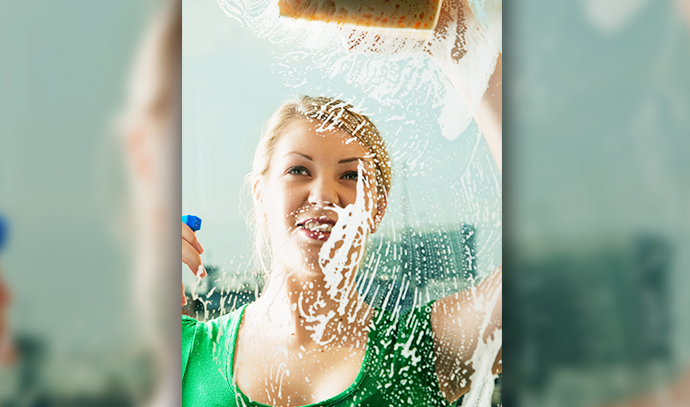portrait-man-cleaning-house-windows
Simple tips to make your windows sparkle
Phyllis, October
2016
There can be few things more annoying (or more neglected) among household chores than dirty windows. Just ask Queen Victoria, whose servants were so disorganised that she often had to guess what the weather was like beyond the filthy panes of Buckingham Palace.
The good news is there are a few simple tricks and tips that the pros use to get a sparkling result. All you need is a ladder, bucket, sponge, rags and squeegee to get started.
 Squeegee technique is important when cleaning your windows[/caption]
If there is a build-up of mud, dirt or poo on the window, wet it down with a rag, then scrape off the excess debris.
Some window cleaning companies say to add a teaspoon of ordinary dishwashing liquid to a bucket of water. But Sydney Window Cleaning has great window washing tips for the DIYer. They recommend thoroughly wetting the scrubber in the bucket of water, then running four or five lines of detergent along it like a hot dog before working it into the applicator with your fingers.
If you’re washing windows in summer, buy yourself a bit more time by using cool water so it won’t evaporate as quickly. It’s also a good idea to work in the cool of the early morning or wait until the sun goes off the windows in the evening. Dip the scrubber into the liquid and wash the glass using horizontal or vertical strokes. If you’re washing inside, prevent drips of water by squeezing out any excess water into the bucket before washing.
Use a rag to wipe along the top edge of the glass, then place the squeegee on the dry edge and pull down, ensuring the rubber is tilted at a 45-degree angle. We’ve all seen professional window cleaners sweep the squeegee back and forth across the window in one continuous motion. But The Family Handyman magazine says this “fanning” technique takes practice to master. Instead, use the rag to wipe the excess water from the rubber and repeat, overlapping the strokes each tip. Clean the other edges with the rag and you’re done.
[caption id="attachment_6048" align="alignnone" width="690"]
Squeegee technique is important when cleaning your windows[/caption]
If there is a build-up of mud, dirt or poo on the window, wet it down with a rag, then scrape off the excess debris.
Some window cleaning companies say to add a teaspoon of ordinary dishwashing liquid to a bucket of water. But Sydney Window Cleaning has great window washing tips for the DIYer. They recommend thoroughly wetting the scrubber in the bucket of water, then running four or five lines of detergent along it like a hot dog before working it into the applicator with your fingers.
If you’re washing windows in summer, buy yourself a bit more time by using cool water so it won’t evaporate as quickly. It’s also a good idea to work in the cool of the early morning or wait until the sun goes off the windows in the evening. Dip the scrubber into the liquid and wash the glass using horizontal or vertical strokes. If you’re washing inside, prevent drips of water by squeezing out any excess water into the bucket before washing.
Use a rag to wipe along the top edge of the glass, then place the squeegee on the dry edge and pull down, ensuring the rubber is tilted at a 45-degree angle. We’ve all seen professional window cleaners sweep the squeegee back and forth across the window in one continuous motion. But The Family Handyman magazine says this “fanning” technique takes practice to master. Instead, use the rag to wipe the excess water from the rubber and repeat, overlapping the strokes each tip. Clean the other edges with the rag and you’re done.
[caption id="attachment_6048" align="alignnone" width="690"] Buckingham Palace has a lot of windows to wash. Image via www.buckinghampalace.co.uk[/caption]
Remember to clean the interior and exterior of windows at the same time. This was the major source of Queen Victoria’s window woes. The Lord Chamberlain’s department was responsible for ensuring the interior of the palace windows were cleaned, while the Woods and Forests Department was supposed to organise the exteriors to be washed. Because these two departments didn’t coordinate (enter Prince Albert who sorted them out) the glass was always so grimy on one side or the other that the Queen literally couldn’t see outside.
Buckingham Palace has a lot of windows to wash. Image via www.buckinghampalace.co.uk[/caption]
Remember to clean the interior and exterior of windows at the same time. This was the major source of Queen Victoria’s window woes. The Lord Chamberlain’s department was responsible for ensuring the interior of the palace windows were cleaned, while the Woods and Forests Department was supposed to organise the exteriors to be washed. Because these two departments didn’t coordinate (enter Prince Albert who sorted them out) the glass was always so grimy on one side or the other that the Queen literally couldn’t see outside.
Invest in a good quality equipment
The keys to success are buying good quality equipment. Search online and there are plenty of professional cleaning and window washing suppliers who can kit you out with the right gear. This will ensure you get a pro result. You’ll need a washer pad that fits onto a t-bar. These come in a choice of abrasive pads, microfiber and cotton. Then there’s a squeegee and replacement blades. (You should replace the blades as soon as they become damaged or rounded or they simply won’t give you a streak-free finish.) You can get a little more mileage out of blades that aren't nicked or sliced by simply reversing them to expose a fresh edge. When you store the squeegee, make sure nothing touches the blade. A bucket sounds obvious, until you get home and find the round one is hard to dip the washer into! Buy a rectangular one, but check the size of your washer first or you may end up with a 35 centimetre bucket and a 45 centimetre washer. The above items may sound obvious, but the next two may not. A scraper will remove any impurities that are caked onto the glass such as mud or bird poo. This will make washing easier and prevent damage to you squeegee blade. Then you’ll also need an extension pole so you can reach the tops of the windows. [caption id="attachment_6050" align="alignnone" width="690"] Squeegee technique is important when cleaning your windows[/caption]
If there is a build-up of mud, dirt or poo on the window, wet it down with a rag, then scrape off the excess debris.
Some window cleaning companies say to add a teaspoon of ordinary dishwashing liquid to a bucket of water. But Sydney Window Cleaning has great window washing tips for the DIYer. They recommend thoroughly wetting the scrubber in the bucket of water, then running four or five lines of detergent along it like a hot dog before working it into the applicator with your fingers.
If you’re washing windows in summer, buy yourself a bit more time by using cool water so it won’t evaporate as quickly. It’s also a good idea to work in the cool of the early morning or wait until the sun goes off the windows in the evening. Dip the scrubber into the liquid and wash the glass using horizontal or vertical strokes. If you’re washing inside, prevent drips of water by squeezing out any excess water into the bucket before washing.
Use a rag to wipe along the top edge of the glass, then place the squeegee on the dry edge and pull down, ensuring the rubber is tilted at a 45-degree angle. We’ve all seen professional window cleaners sweep the squeegee back and forth across the window in one continuous motion. But The Family Handyman magazine says this “fanning” technique takes practice to master. Instead, use the rag to wipe the excess water from the rubber and repeat, overlapping the strokes each tip. Clean the other edges with the rag and you’re done.
[caption id="attachment_6048" align="alignnone" width="690"]
Squeegee technique is important when cleaning your windows[/caption]
If there is a build-up of mud, dirt or poo on the window, wet it down with a rag, then scrape off the excess debris.
Some window cleaning companies say to add a teaspoon of ordinary dishwashing liquid to a bucket of water. But Sydney Window Cleaning has great window washing tips for the DIYer. They recommend thoroughly wetting the scrubber in the bucket of water, then running four or five lines of detergent along it like a hot dog before working it into the applicator with your fingers.
If you’re washing windows in summer, buy yourself a bit more time by using cool water so it won’t evaporate as quickly. It’s also a good idea to work in the cool of the early morning or wait until the sun goes off the windows in the evening. Dip the scrubber into the liquid and wash the glass using horizontal or vertical strokes. If you’re washing inside, prevent drips of water by squeezing out any excess water into the bucket before washing.
Use a rag to wipe along the top edge of the glass, then place the squeegee on the dry edge and pull down, ensuring the rubber is tilted at a 45-degree angle. We’ve all seen professional window cleaners sweep the squeegee back and forth across the window in one continuous motion. But The Family Handyman magazine says this “fanning” technique takes practice to master. Instead, use the rag to wipe the excess water from the rubber and repeat, overlapping the strokes each tip. Clean the other edges with the rag and you’re done.
[caption id="attachment_6048" align="alignnone" width="690"] Buckingham Palace has a lot of windows to wash. Image via www.buckinghampalace.co.uk[/caption]
Remember to clean the interior and exterior of windows at the same time. This was the major source of Queen Victoria’s window woes. The Lord Chamberlain’s department was responsible for ensuring the interior of the palace windows were cleaned, while the Woods and Forests Department was supposed to organise the exteriors to be washed. Because these two departments didn’t coordinate (enter Prince Albert who sorted them out) the glass was always so grimy on one side or the other that the Queen literally couldn’t see outside.
Buckingham Palace has a lot of windows to wash. Image via www.buckinghampalace.co.uk[/caption]
Remember to clean the interior and exterior of windows at the same time. This was the major source of Queen Victoria’s window woes. The Lord Chamberlain’s department was responsible for ensuring the interior of the palace windows were cleaned, while the Woods and Forests Department was supposed to organise the exteriors to be washed. Because these two departments didn’t coordinate (enter Prince Albert who sorted them out) the glass was always so grimy on one side or the other that the Queen literally couldn’t see outside.


